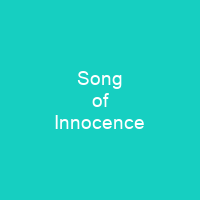Song of Innocence is the debut album by American composer and producer David Axelrod. It was released in October 1968 by Capitol Records. Axelrod sought to capitalize on the experimental climate of popular music. The record’s best-known song, “Holy Thursday,” was frequently sampled by hip hop producers.
About Song of Innocence in brief

He originally wanted the album to feature a large-scale choir, but was uncertain if he could find the sounds appropriate for a recording. He conceived the album after he had bought an edition of Blake’s complete poetry while working in Capitol’s art department and considered the concept for a few years before Mass in F Minor. He wanted to adapt works by English poet William Blake on an album. Numerous serious music composers had set his poems to music since the 1870s, and the practice was eventually adapted in other musical fields during the 20th-century, including popular music, musical theatre, and folk idiom. He was one of several Los Angeles-based musical eccentrics during the late 1960s who wanted to expand on the mid-1960s studio experiments of Brian Wilson and George Martin. His first attempt at this creative vision was composing a religious-themed, psychedelic opera for the Electric Prunes, a local garage rock group. When the band found it too challenging to finish the recording, Axelrod enlisted studio musicians to complete the album, released as Mass In F Minor in 1968. He considered the poet very bad at making new friends, and felt that he could identify with Blake; he considered him to be a self-professed \”Blake freak\”, Axelrod had been fascinated by Blake’s painting and poetry since his late teens and frequently read the poems as an adult. He had worked with them before when producing artists for Capitol sessions for Capitol.
You want to know more about Song of Innocence?
This page is based on the article Song of Innocence published in Wikipedia (as of Dec. 05, 2020) and was automatically summarized using artificial intelligence.







